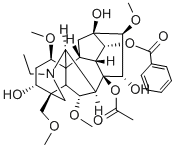
Аконитин
- английское имяAconitine
- CAS №302-27-2
- CBNumberCB1343300
- ФормулаC34H47NO11
- мольный вес645.74
- EINECS206-121-7
- номер MDLMFCD00082375
- файл Mol302-27-2.mol
химическое свойство
| Температура плавления | 200-205 °C (dec.) |
| альфа | D +17.3° (chloroform) |
| Температура кипения | 675.12°C (rough estimate) |
| плотность | 1.2181 (rough estimate) |
| показатель преломления | 1.6630 (estimate) |
| температура хранения | Refrigerator |
| растворимость | Soluble in ethanol; |
| форма | White to off-white powder. |
| пка | 5.88(at 25℃) |
| цвет | White |
| оптическая активность | +18.224 (c 1.5, CHCl3) |
| Растворимость в воде | Soluble in ethanol. Sparingly soluble in water |
| Мерк | 13,120 |
| Справочник по базе данных CAS | 302-27-2 |
| Рейтинг продуктов питания EWG | 1-5 |
| FDA UNII | X8YN71D5WC |
| Справочник по химии NIST | Aconitine(302-27-2) |
| UNSPSC Code | 12352200 |
| NACRES | NA.77 |
больше
| Коды опасности | T+,Xi |
| Заявления о рисках | 26/28-36/37/38 |
| Заявления о безопасности | 24-45-36-26 |
| РИДАДР | UN 1544 6.1/PG 1 |
| WGK Германия | 2 |
| RTECS | AR5960000 |
| F | 10-34 |
| Класс опасности | 6.1(a) |
| Группа упаковки | I |
| Токсичность | LD50 in mice (mg/kg): 0.166 i.v.; 0.328 i.p.; approx 1 orally (Dybing); also reported as LD50 in mice (mg/kg): 1.8 orally, 0.270 s.c.; 0.380 i.p.; 0.12 i.v. (Sato) |
рисовальное письмо(GHS)
-
рисовальное письмо(GHS)

-
сигнальный язык
опасность
-
вредная бумага
H300+H330:Смертельно при проглатывании или при вдыхании.
-
оператор предупредительных мер
P301+P310+P330:ПРИ ПРОГЛАТЫВАНИИ: Немедленно обратиться за медицинской помощью. Прополоскать рот.
P304+P340+P310:ПРИ ВДЫХАНИИ: Свежий воздух, покой. Немедленно обратиться за медицинской помощью.
Аконитин химические свойства, назначение, производство
Описание
Aconitum plants (Wu Tou, Ranunculaceae family) have been widely used to treat various diseases, such as rheumatism, knee pain, herpes zoster, scabies, and other disorders in China for thousands of years. It was first described in Shen Nong’s Herbal Classic (the earliest classical work of Chinese herbs). Aconitine is the main active component in Aconitum plants.Химические свойства
Off-White SolidФизические свойства
Appearance: solid. Solubility: barely soluble in water and soluble in organic solvents such as chloroform or diethyl ether. Its solubility in water and ethanol are 0.3?mg/mL and 35?mg/mL, respectively. Melting point: 203–204?°C (397–399?°F; 476–477?K). Optical rotation:D+17.3°История
Preparations of Aconitum roots are employed in Chinese medicine for analgesic, antirheumatic, and neurological indications. In the Ming Dynasty, Chinese people had extracted the aconitine from the Aconitum plants. Aconitine is synthesized by the Aconitum plants via the terpenoid biosynthesis pathway (MEP chloroplast pathway)Использование
Neurotoxin. Activates tetrodotoxin-sensitive Na+ channels, inducing presynaptic depolarization, thus blocking the nerve action potential which, in turn, blocks the release of neurotransmitters and dec reases the end plate potential at the neuromuscular junction. Aconitine also blocks norepinephrine reuptake. In the heart, aconitine induces ventricular tachycardia after intracoronary injection. In c ultured ventricular myocytes, aconitine increases the duration of the action potential and induces the appearance of early after depolarization. Used in producing heart arrhythmia in experimental anim als.Определение
ChEBI: A diterpenoid that is 20-ethyl-3alpha,13,15alpha-trihydroxy-1alpha,6alpha,16beta-trimethoxy-4-(methoxymethyl)aconitane-8,14alpha-diol having acetate and b nzoate groups at the 8- and 14-positions respectively.Показания
Aconitine was previously used as an antipyretic and analgesic. However, the clinical application of aconitine is limited by its high toxicity. Its lethal dose 50% (LD50) for mice is 1.8?mg/kg (orally) and 0.308?mg/kg (intraperitoneally).Угроза здоровью
Aconitine is among the most toxic alkaloidsknown. Toxic doses are close to therapeuticdoses, and in humans as little as 2 mgmay cause death (Ferry and Vigneau 1983).An oral lethal dose of 28 mg/kg has alsobeen recorded (NIOSH 1986). The toxicsymptoms at low doses may be excitement,drowsiness, and hypermotility. The first signof poisoning from ingestion is a tingling,burning feeling on the lips, mouth, gums,and throat (Hodgson et al. 1988). This isfollowed by nervous disorders, anesthesia,loss of coordination, vertigo, hypersalivation,nausea, vomiting, and diarrhea. Toxic actionsof aconitine are very rapid. The crystallineform of this compound is much more toxicthan the amorphous aconitine. At a lethaldose, death may result from cardiorespiratoryfailure. Procaine may be an effective antidoteagainst aconitine poisoning.Фармаколо?гия
Aconitum was found to have neurotoxin. It could activate tetrodotoxin-sensitive Na+ channels, inducing presynaptic depolarization and blocking the nerve action potential and, in turn, blocking the release of neurotransmitters and decreasing the end plate potential at the neuromuscular junction. Aconitine was also found to block norepinephrine reuptakeIn the heart, aconitine could induce ventricular tachycardia. In cultured ventricular myocytes, aconitine could induce the appearance of early after depolarization by increasing the duration of the action potential.
Research with mouse nerve-hemidiaphragm muscle preparation found that aconitine at low concentrations (<0.1?μM) could increase the electrically evoked acetylcholine release causing an induced muscle tension. Action potentials were generated more often at this concentration. While at higher concentrations (0.3–3?μM), aconitine could decrease the electrically evoked acetylcholine release, resulting in a decrease in muscle tension. Under the circumstance with high concentration (0.3–3?μM) of aconitine, the sodium-ion channels were constantly activated, and transmission of action potentials was suppressed, leading to the formation of non-excitable target cells or paralysis.
Клиническое использование
In clinic, it can be used for treating and alleviating the symptoms caused by arthritis, lumbocrural pain, and herpes zoster; however, it is utilized infrequently in clinical practice due to its obvious side effectsAccording to a review of different reports of aconite poisoning in human beings, the following clinical features such as neurological, cardiovascular, and gastrointestinal features were observed. The first symptom of aconitine poisoning appeared approximately 20?min–2?h after oral intake, and they were paresthesia, sweating, and nausea, which led to severe vomiting, colicky diarrhea, intense pain, and then paralysis of the skeletal muscles. Following the onset of life-threatening arrhythmia, including ventricular tachycardia and ventricular fibrillation, death finally occurred as a result of respiratory paralysis or cardiac arrest.
Методы очистки
Crystallise it from EtOH, CHCl3 or toluene. [Beilstein 21/6 V 310.]Аконитин запасные части и сырье
запасной предмет